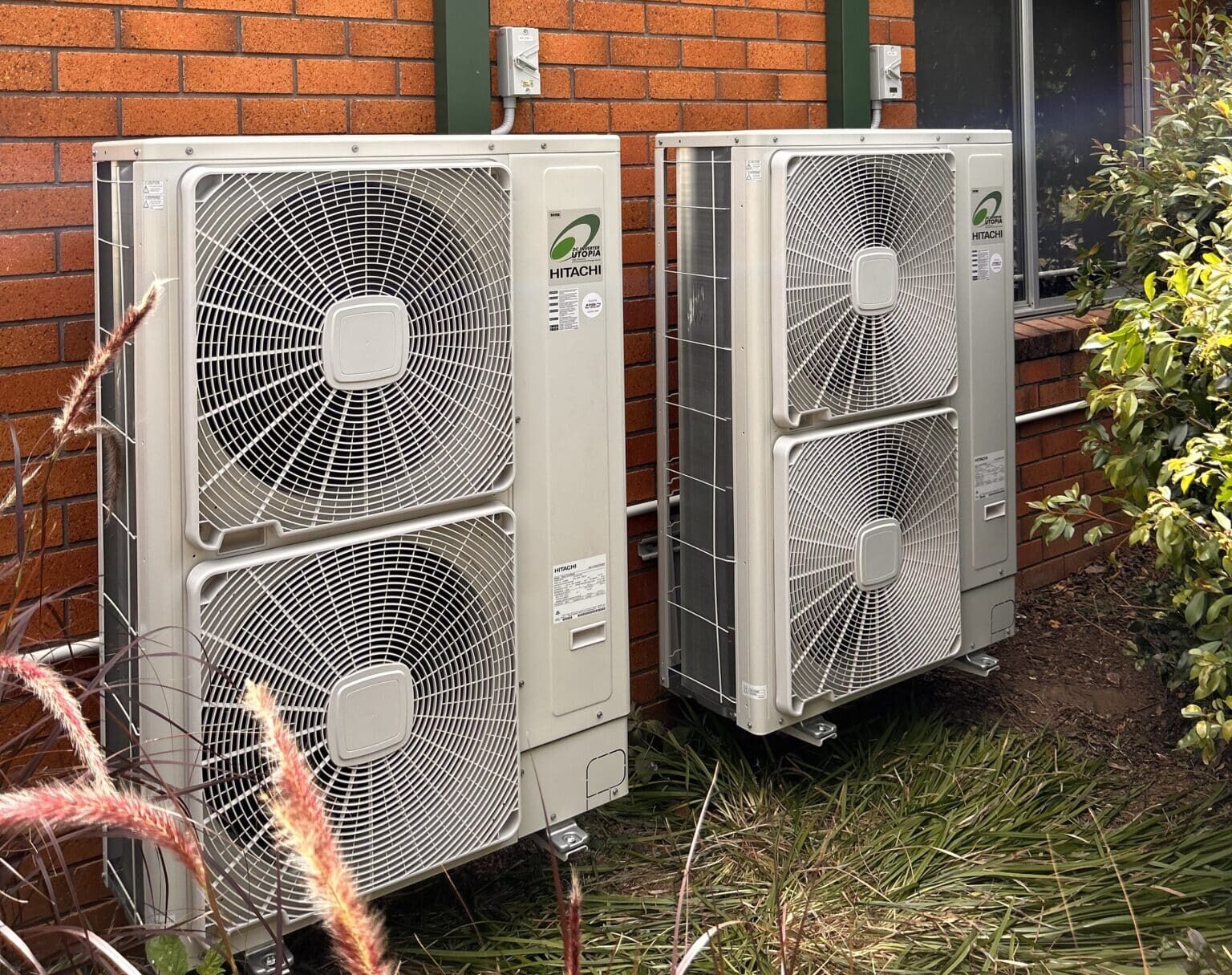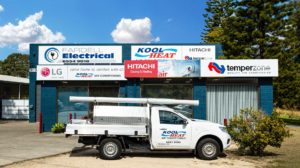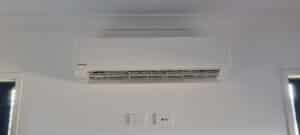When we’re deciding between ducted and split system air conditioning, it comes down to efficiency and space needs. Ducted systems excel in large areas with consistent temperature control, but they require a higher initial investment. They’re optimal over time for big homes. Split systems, cheaper and easier to install, fit well in smaller areas and varied conditions. Both demand routine maintenance to extend lifespan and ensure peak performance.
With professional installation and service, we can maximize savings and comfort. If we’re curious about long-term benefits, cost comparisons, and smart provider choices, let’s explore further for comprehensive insights.
Key Takeaways
– Ducted systems are more efficient for large spaces, while split systems excel in smaller areas.
– Split systems are generally cheaper to install, making them appealing for many households.
– Ducted systems offer consistent temperature control, especially in extreme climates.
– Split systems provide versatility and easier installation in varied conditions.
– Ducted systems have higher upfront costs but may be cost-effective over time in large homes.
Expert Installation Services
Our expert installation services ensure that your new air conditioning system is set up efficiently and flawlessly from the start. We’re committed to helping you choose between ducted and split systems by focusing on energy efficiency. Both systems have their merits, but each one impacts your energy bills differently.
During the cost comparison phase, we analyse potential savings over time, ensuring you make the most financially sound decision.
Our installation process is straightforward and designed to minimize disruption to your daily routine. We assess your space requirements carefully, ensuring the system you select fits seamlessly into your home or business.
Ducted systems might require more space initially, but they often offer a more uniform cooling experience. On the other hand, split systems are perfect for targeted cooling with minimal invasive installation.
The long-term benefits of our installation services include not just immediate comfort, but also peace of mind knowing your system is optimized for performance and longevity. By choosing our expert services, you’re investing in a system that will serve you reliably, minimizing future repair costs and enhancing your property’s value over time.
Routine Maintenance Options
To keep your air conditioning system running efficiently, we prioritize routine maintenance tailored to both ducted and split systems. Regular attention to these systems not only extends their lifespan but also ensures optimal performance throughout the year. We encourage a combination of DIY maintenance and professional servicing to cover all bases.
Let’s start with DIY maintenance. Regularly cleaning filters is crucial; it helps maintain airflow and improves air quality. For both ducted and split systems, clean filters at least every few months, or more frequently if the system is heavily used.
Seasonal check ups are another key component. As seasons change, so do your air conditioning needs. Scheduling seasonal check ups ensures that any minor issues are caught early before they become costly problems.
During these check ups, it’s important to check refrigerant levels. Maintaining proper refrigerant levels is essential for efficient cooling and preventing system strain.
Efficient Repair Solutions
Effective repair solutions ensure that your air conditioning system operates smoothly, minimizing downtime and extending its lifespan. We often face common issues like refrigerant leaks, clogged filters, or malfunctioning thermostats. Addressing these promptly is crucial.
For minor issues, DIY troubleshooting is a great start. Checking and replacing filters, or ensuring the thermostat is correctly set, can sometimes resolve problems without needing professional assistance.
However, when more complex issues arise, a professional diagnosis is vital. Our trained technicians can pinpoint problems that aren’t immediately obvious, ensuring that we address the root cause rather than just the symptoms. This approach not only results in cost-effective repairs but also prevents recurring issues that could become costly over time.
Incorporating energy-saving tips during repairs can further enhance efficiency. For example, ensuring proper insulation around the ductwork or optimizing the system’s settings can significantly reduce energy consumption.
Types of Air Conditioning Systems
Exploring the types of air conditioning systems available helps us find the perfect solution tailored to individual needs, whether it’s ducted or split systems.
First, let’s consider the energy efficiency comparison. Ducted systems often offer greater efficiency for large spaces, distributing air evenly throughout the home, while split systems shine in smaller areas, allowing us to control energy use room by room.
Next, cost considerations come into play. Ducted systems generally involve higher upfront costs due to complex installation, but they might prove cost-effective over time in large homes. Split systems, on the other hand, are typically less expensive to install, making them an appealing choice for many households.
When assessing climate suitability, ducted systems provide consistent temperature control in climates with extreme temperatures, whereas split systems are versatile and suit varied conditions.
The installation process is crucial, too; ducted systems require extensive setup, often involving ceiling modifications, while split systems are easier to install, with minimal disruption.
Choosing the Right Provider
Selecting the right provider for your air conditioning needs is crucial to ensuring efficient installation and long-term reliability. When we’re in the market for a ducted or split system, we need to consider several key factors that will help us make an informed decision.
A reliable provider can make all the difference in the performance and longevity of our air conditioning system.
To choose wisely, we should focus on:
– Provider reliability: We must research providers with a proven track record of dependable service and expertise in air conditioning systems.
– Warranty coverage: It’s essential that we understand the warranty terms offered by the provider to protect our investment and ensure peace of mind.
– Energy efficiency: We should opt for a provider that offers energy-efficient solutions, helping us save on energy bills and reduce our carbon footprint.
– Cost comparison: Evaluating the costs involved, including installation and maintenance, helps us ensure we’re getting the best value for our money.
– Customer reviews: Finally, we should read customer reviews to gauge the provider’s reputation and the experiences of others.
Frequently Asked Questions
What Are the Energy Efficiency Differences Between Ducted and Split Systems?
We’re often asked about the energy efficiency of air conditioning systems. When considering environmental impact and energy savings, split systems generally have higher efficiency ratings. They offer better climate control and temperature consistency.
Ducted systems, however, provide insulation benefits and superior airflow distribution. While installation costs are higher for ducted systems, they can offer long-term savings.
Both require regular maintenance to ensure they’re operating efficiently and effectively.
How Does the Cost of Running a Ducted System Compare to a Split System?
Let’s tackle the cost comparison first. Running costs for systems depend on energy efficiency, maintenance expenses, and electricity usage.
While upfront installation costs vary, ducted systems often require a higher initial investment. However, they provide excellent climate control and temperature consistency.
Split systems might offer long-term savings due to lower maintenance expenses and reduced environmental impact. We must weigh these factors to decide which system suits our needs best.
Can Ducted Systems Provide Heating as Well as Cooling?
Yes, ducted systems can provide both heating and cooling. We enjoy their efficient climate control capabilities. They often require proper insulation to maximize efficiency, and maintenance frequency is crucial for optimal performance.
With versatile thermostat options, we can easily manage air distribution throughout the property. These systems offer seamless climate control, keeping us comfortable no matter the season.
Let’s ensure regular checks to maintain their effectiveness and longevity.
Are Split Systems Easier to Install in Existing Homes?
We often find ourselves questioning if split systems are easier to install in existing homes.
The installation process is generally simpler due to fewer space requirements compared to other systems. They offer flexibility options, making them suitable for various room sizes without significant alterations.
Aesthetics impact is minimal as they blend well with interior décor. Plus, maintenance needs are straightforward, ensuring efficient operation over time.
Which System Is Quieter During Operation, Ducted or Split?
When discussing which system is quieter, we consider noise levels. Split systems tend to be quieter indoors since the noisier components are outside. However, ducted systems distribute sound more evenly.
In terms of maintenance, split systems require less upkeep. Aesthetically, ducted systems offer a cleaner look. For climate control, both provide excellent options, but ducted systems excel in whole-home solutions.
Long-term savings can vary based on usage and system efficiency.
Conclusion
In our journey through ducted and split systems, we’ve explored the ins and outs of each option.
We’ve seen how expert installation, routine maintenance, and efficient repairs play critical roles in their performance.
Choosing the right provider is just as important as picking the right system.
Ultimately, the best choice hinges on our specific needs and preferences.
With this knowledge, we’re ready to make a confident decision that ensures lasting comfort and satisfaction.



